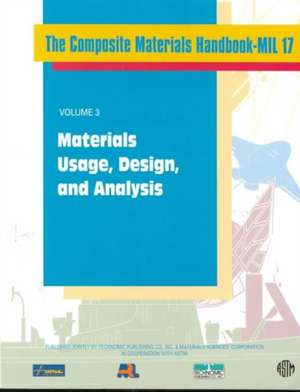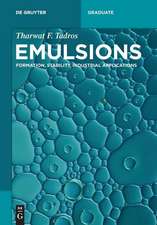Composite Materials Handbook-MIL 17, Volume III: Materials Usage, Design, and Analysis
Autor US Dept of Defenseen Limba Engleză Hardback – 18 iun 1999
This volume provides methodologies and lessons learned for the design, manufacture, and analysis of composite structures and for utilization of the material data provided in Volume II consistent with the guidance provided in Volume I. It covers processes and effects of variability; quality control of production materials; design and analysis; structural behavior of joints and reliability; thick section composites; and supportability.
Preț: 861.36 lei
Preț vechi: 1050.44 lei
-18% Nou
Puncte Express: 1292
Preț estimativ în valută:
164.81€ • 172.10$ • 136.10£
164.81€ • 172.10$ • 136.10£
Carte tipărită la comandă
Livrare economică 15-29 aprilie
Preluare comenzi: 021 569.72.76
Specificații
ISBN-13: 9781566768283
ISBN-10: 1566768284
Pagini: 392
Ilustrații: Illustrations
Dimensiuni: 219 x 276 x 22 mm
Greutate: 1.16 kg
Ediția:1
Editura: CRC Press
Colecția CRC Press
ISBN-10: 1566768284
Pagini: 392
Ilustrații: Illustrations
Dimensiuni: 219 x 276 x 22 mm
Greutate: 1.16 kg
Ediția:1
Editura: CRC Press
Colecția CRC Press
Public țintă
ProfessionalCuprins
Introduction. Materials and Processes - Effects of Variability on Composite Properties. Quality Control of Production Materials. Design and Analysis. Structural Behavior of Joints. Structural Reliability. Thick Section Composites. Supportability. Lessons Learned. Index.
Descriere
This standardization handbook has been developed and is being maintained as a joint effort of the Department of Defense and the Federal Aviation Administration. It provides guidelines and material properties for polymer (organic) and metal matrix composite materials. This handbook aims to provide a standard source of statistically-based mechanical property data, procedures, and overall materials guidelines for characterization of composite material systems. This volume provides methodologies and lessons learned for the design, manufacture, and analysis of composite structures and for utilization of the material data provided in Volume II consistent with the guidance provided in Volume I. It covers processes and effects of variability; quality control of production materials; design and analysis; structural behavior of joints and reliability; thick section composites; and supportability.





